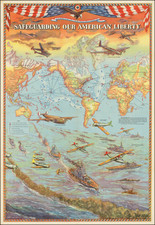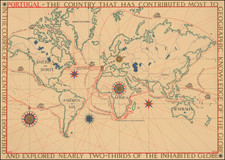Geological Epochs of Earth
Geological map based on Ami Boué's 1845 map Carte géologique du globe terrestre. Published for the 1856 Physical Atlas of Natural Phenomena by Alexander Keith Johnston, this thematic map presents a scientific view of the world's geology according to established conventions of the mid-19th century. Boué, a founder of the Société géologique de France, described the process now known as granitization in 1824. This knowledge is reflected in elegant hand coloring accompanied by inset maps and illustrations that further expand on the geological information presented.
Immediately one is drawn to the vivid colors that populate the map. These colors reflect in which epoch the rocks that make up a region were created. As this data can vary wildly across a region, the map is quite colorful, particularly in locations that have been studied more extensively such as Europe and North America. Volcanic rock, shown in red, covers all of Iceland as well as more isolated instances such as Giant's Causeway in Northern Ireland.
The geological focus of the map is the more noteworthy aspect, but this chart is still a nice depiction of the world according to European knowledge of the time. Major cities of the world as depicted throughout as are notable mountain ranges such as the recently named Himalayas range. An inset map shows the coastline of the "supposed Antarctic Continent," and bears the names of Antarctic explorers Bellinghausen, Weddel, Biscoe, and Cook.











![[ World Powers - Confrontation or Relaxation? ] Weltmachte-Konfrontation oder Entspannung?](https://storage.googleapis.com/raremaps/img/small/90939.jpg)
![[WWI British Propaganda Map in Italian] L’impero Britannico in Guerra](https://storage.googleapis.com/raremaps/img/small/86441.jpg)
![[Second World War-era Japanese Pencil Sharpener Map of the World]](https://storage.googleapis.com/raremaps/img/small/84609.jpg)
![[Coffee, Tea, Vanilla & Spices / Pictorial Map of the World -- McCormick & Company]](https://storage.googleapis.com/raremaps/img/small/100117.jpg)